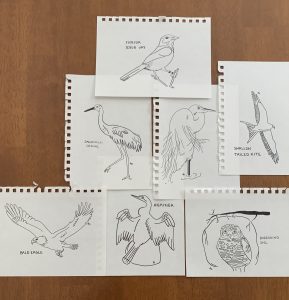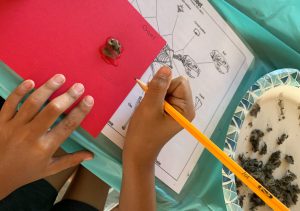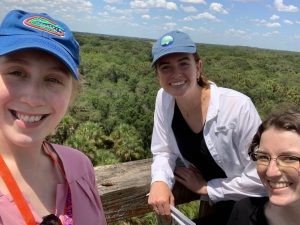Hello! I’m Adelaide Mahler, one of the Environmental Education and Outreach interns at UF/IFAS Extension Sarasota County this summer. Moreover, I’m an individual terribly in love with the environment (and education). So, read on to learn a bit about what I got up to this summer and how I see learning as a means of reciprocity.
Adelaide was an amazing intern this summer and we thank her for all her hard work, dedication and professionalism. We wish her the best as she carries forward her love of nature and education into her future endeavors! During her time with us, she created a comic-book inspired invasive species educational display, wrote 16 blogs, created 3 webinars and delivered 2 of them, starred in an owl pellet dissection video, conducted historical interviews, drew 44 illustratrations… and so much more! Thank you Adelaide! -Dr. Katherine Clements
What I Got To Do

I picked this heading with purpose. While I’m very intentional with all that I write, it truly was a privilege intern for the Sarasota County Intern program within the Ecology and Natural Resources Program at Extension. I got to do a lot, and I’m so happy to share some of my projects and experiences.
Education and Outreach
An appropriate title, the majority of my internship was geared towards public education and outreach (you all!). This included youth education such as building and delivering lessons plans for our 4-H Exploring Your Environment Day Camp and day camp programming for Girls, Inc. and Unidos Now. For adults, I was deeply involved in the Wild Sarasota programming writing blogs, revamping our webpage, and even conducting my own webinars on white-tailed deer and the woodpeckers of Florida. The material was rather ornithology (bird) heavy; however, I learned and taught a lot about sea turtles, epiphytes, and all kinds of invasive species found here in Florida as well.
Field Work
Any intern’s dream, I was fortunate enough to get out in the field. I sampled reclaimed water for nitrogen, tagged nesting sea turtles, went out on sea turtle hatchling patrol, and surveyed Florida scrub-jays. Though the majority of these opportunities left me a little shy on sleep, they were all gratifying experiences for which I’m very grateful. For more details, you can read my blogs on Jay Watch and sea turtle surveying.
GIS Story Mapping

This is where I had the opportunity to get a little more creative. As part of the Ecology and Natural Resource Program at UF/IFAS Extension and Parks, Recreation and Natural Resources of Sarasota County’s joint effort to create story maps for prominent parks and preserves in the area, I got to hunt through archives, rifle through historic land use maps, and conduct interviews with local experts and land-lovers. Learning the history of some of our county’s preserves allowed me to connect with and appreciate the land in ways I never had before. That said, my favorite part was illustrating over thirty species for coloring pages and building scavenger hunt zines (or mini, printable booklets) tailored to the ecology of specific areas. Though they’re yet to be released, keep your eyes peeled for the story map drops — they’re sure to change your park-visiting experience.
Learn more about the Sarasota County Internship program HERE
Love and Learning (and vice versa)

Bolstered by my experiences this summer, I’m convinced that the ecological “gift” of the human species is our ability for compassion and curiosity. More specifically, the interplay between these two gifts.
Some are familiar with the term “ecosystem services” to refer to the offerings of different species or habitats to the environment. This includes providing habitat for other species, providing resources or entertainment for humans, being valuable medicine, and much more. These are all gifts.
As an environmental educator, I hope to make people aware of these gifts and the reality that they won’t be there forever. But that takes a baseline of understanding and compassion. And that’s — to an even greater degree — the beauty of environmental education. By explaining natural phenomena, identifying species, and even just taking people outside, they’re connecting with the environment, getting curious, and starting to care for and take notice of all that’s going on around them. And then wanting to know even more; the synergy of learning and loving.
While it’s important to notice (and be grateful for) all that the environment gives, the best way we can repay nature for all gifts is to fight for them. And this is done with our gifts as individuals. How can you best repay the environment? What is your gift?
I believe mine is somehow involved with my passion for education. Whether it be a one-on-one teaching interaction, lecturing in front of a bigger audience, environmental illustrations, or writing a blog, teaching and fostering more connections with the environment is my way of reciprocating. I encourage you all to learn about your environment, to love all that it does for you, and to explore what you may be able to do in return. Just as gopher tortoises have the burrowing adaptation (an individual gift) that allows them to provide habitat for over 400 other species (an ecosystem service, or gift to others) there’s something unique about you that allows you to give in certain ways. So, I leave you to wonder: what natural aptitudes or acquired skills do you have that can make a difference?
Acknowledgements and Gratitude
As much as this was a conclusion I reached on my own, the philosophy outlined above is a reflection of my interactions with and perspectives of individuals I’ve had the pleasure of engaging with this summer and over the course of my life. In particular, I would like to thank Dr. Katherine Clements for her encouragement and, more importantly, her dedication to and passion for environmental education. She’s an inspiration and enabled me to do so much. My fellow interns, Kassidy House and Cailyn Raper, brought much joy, conversation, and companionship these past twelves weeks — much love and appreciation to them.
Other thanks to Angela Bright, Lee Hayes Byron, Sarah Davis, Jenny Drake, Melinda Gorman, Mindy Hanak, Sara Kane, Jackie Lebouitz, Kevin O’Horan, Randy Penn, Abbey Tyrna, Armando Ubeda, Carol Wyatt-Evans, and others at the Extension Office for all their help, smiles, and nuggets of wisdom. I learned so much thanks to the nurturing environment at the “Green Building”.
Finally, I would be remiss not to mention that I leaned heavily on the thoughts of Robin Wall Kimmerer and her meditations on the Indigenous wisdom of reciprocity and gift giving. In particular, I’ve found “The Gift of Strawberries”, “Learning the Grammar of Animacy”, and the Epilogue “Returning the Gift” of Braiding Sweetgrass to be particularly influential.
 1
1





